WATER RESOURCES MANAGEMENTWater Resources Management
WATER RESOURCES OVERVIEWWater Resources Overview
Hsin Tung Yang's water consumption management encompasses data from Dayuan Plant and the headquarters building. All water consumed comes from tap water, and Dayuan Plant's water use accounts for approximately 96% of all Hsin Tung Yang's water use.%。
| Scope | Item | 2017 | 2018 | 2019 |
|---|---|---|---|---|
| Dayuan Plant | Water consumption (tap water) | 96,863 | 163,989 | 80,159 |
| Water consumption (recycled water) | - | 14,573 | 13,083 | |
| Wastewater treatment volume | 77,372 | 90,467 | 52,727 | |
| Headquarters | Water consumption (tap water) | 3,802 | 3,762 | 3,684 |
| Total | Total water use | 100,665 | 182,324 | 96,926 |
| Scope | Item | 2017 |
|---|---|---|
| Dayuan Plant | Water consumption (tap water) | 96,863 |
| Water consumption (recycled water) | - | |
| Wastewater treatment volume | 77,372 | |
| Headquarters | Water consumption (tap water) | 3,802 |
| Total | Total water use | 100,665 |
| Scope | Item | 2018 |
|---|---|---|
| Dayuan Plant | Water consumption (tap water) | 163,989 |
| Water consumption (recycled water) | 14,573 | |
| Wastewater treatment volume | 90,467 | |
| Headquarters | Water consumption (tap water) | 3,762 |
| Total | Total water use | 182,324 |
| Scope | Item | 2019 |
|---|---|---|
| Dayuan Plant | Water consumption (tap water) | 80,159 |
| Water consumption (recycled water) | 13,083 | |
| Wastewater treatment volume | 52,727 | |
| Headquarters | Water consumption (tap water) | 3,684 |
| Total | Total water use | 96,926 |
(Unit: tons)
(Note: water consumption in 2018 had increased due to water leakage from two concealed pipes)
Water Balance Chart
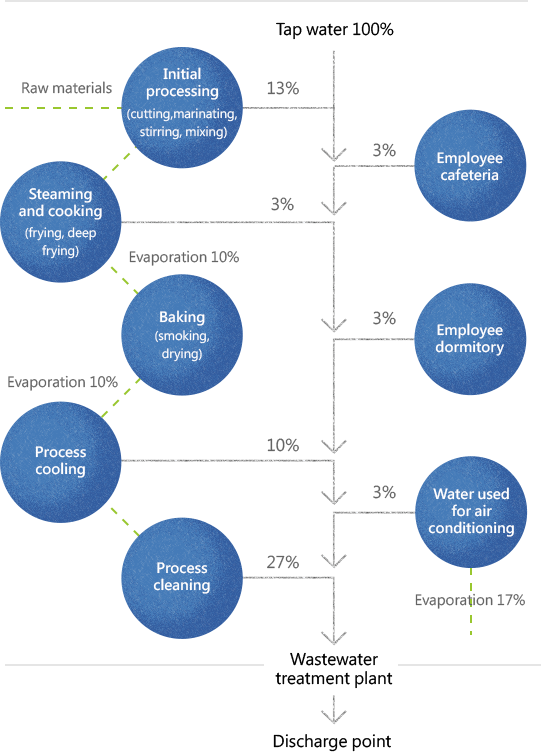
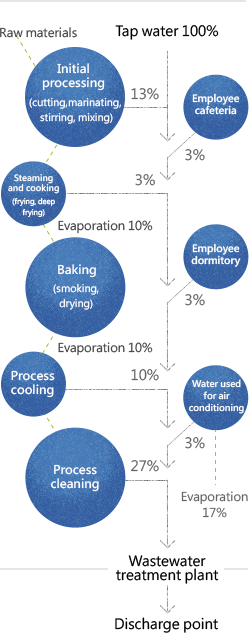
Upholding our principle for "water conservation and effective water use," Hsin Tung Yang has proposed water resource management programs through setting three strategies, namely, reducing water use, recycling, and reuse.
【Water intake】
average daily water use during production was approximately 300 tons.
【Water use】
our process water is tap water treated with precision filter and activated carbon filter, and is used during production and processing.
The water is classified as generic water consumption, or tap water directly supplied to dormitory, and fire prevention consumption, and soft water, which is tap water softened with ion-exchange resin and used as cooling water for air conditioners.
【Discharge】
wastewater mostly comes from the process cleaning water in the plant and domestic wastewater. It is organic and all of which flows through the wastewater pipes within the plant to the wastewater treatment plant at Dayuan industrial area.
【Storage】
o maintain the real-time water loading during production and external water outage or limitations, a storage reservoir and water tower have been established within the plant. Approximately 600 tons of water can be stored cumulatively, and can supply up to 2-3 days of water for the plant.
WATER RESOURCES MANAGEMENT MEASURESWater Resources Management Measures
Digital management
- Dayuan Plant: a water consumption chart and water balance chart are established, and electronic water grids are set up at each major pipeline of the water supply system.
Ensuring water quality
- Dayuan Plant: water quality detection and control is conducted three times in every week, and water storage reservoir is cleaned once every six months
Water resource recycling and reuse
- Dayuan Plant: cooling water for sterilizers is recycled and reused, saving 12,015 tons of cooling water in a year
- Highway service areas: water circulation system is adopted for ponds or aquariums, and rainwater is collected at the rooftop for watering of plants
- Headquarters: touchless faucets and water-saving toilets are used
ATER SAVING EFFECTEffectiveness of Water Conservation
Dayuan Plant - Recycling Cooling Water of Processing Equipment
There are three aluminum can sterilizers at Dayuan Plant and each uses water heated up to 120°C for sterilization. After recycling, the sterilizers are cooled at room-temperature, which requiring 15 tons of water for cooling, which is directly discharged to wastewater treatment plant. Not only does this process consume large quantities of water, but also incurs wastewater discharge processing fee. In 2016, Dayuan Plant resolved to recycle and reuse the 15 tons of cooling water to conserve water use and to reduce waste. After implementation of this program, approximately 12,015 tons of cooling water can be conserved in each year.
Xihu service area - Installation of Water Circulation System at the Pond
The pond at Xihu service area filters impurities with three types of natural minerals, and uses nitrobacter generated through the natural ecosystem to activate the water in the pond and thereby keeps the water clear. Since minerals can extend the filtration effect, the cycle of the pond is extended from two weeks to one quarter, and helps to conserve 4,800 tons of water in each year.
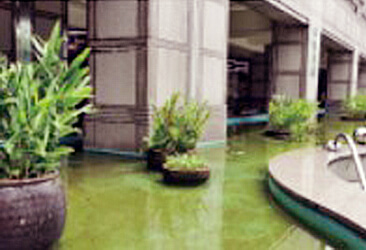
Xihu service area - Installation of Water Circulation System at the Pond
The pond at Xihu service area filters impurities with three types of natural minerals, and uses nitrobacter generated through the natural ecosystem to activate the water in the pond and thereby keeps the water clear. Since minerals can extend the filtration effect, the cycle of the pond is extended from two weeks to one quarter, and helps to conserve 4,800 tons of water in each year.
WASTEWATER MANAGEMENT MEASURESWastewater Management Measures
Wastewater from the plant mostly comes from cleaning processing waste and domestic wastewater. It is organic and approximately 300 CMD of wastewater is generated on average. All wastewater flows through the wastewater pipes within the plant to the wastewater treatment plant at Dayuan industrial area. Wastewater treatment is carried out and managed in line with Water Pollution Control Act and "Wastewater Treatment Facility SOP" and "Water Pollution Preventive Measures Program" within our plant. Dayuan Management Center audits the water quality of wastewater discharged from our plant on a monthly basis, and commissions external wastewater quality inspection in every six months in line with regulations. The average water quality inspection data from 2019 is as follows:
| Water qualityItem | BOD5 | COD | SS | pH |
|---|---|---|---|---|
| Control standard | 240mg/L | 480mg/L | 240mg/L | 5~9 |
| Wastewater at source | 336.5mg/L | 704.5mg/L | 220mg/L | 6.25 |
| Wastewater discharge | 9.3mg/L | 46.2mg/L | 14.3mg/L | 7.05 |
| BOD5 | 240mg/L |
|---|---|
| COD | 480mg/L |
| SS | 240mg/L |
| pH | 5~9 |
| BOD5 | 336.5mg/L |
|---|---|
| COD | 704.5mg/L |
| SS | 220mg/L |
| pH | 6.25 |
| BOD5 | 9.3mg/L |
|---|---|
| COD | 46.2mg/L |
| SS | 14.3mg/L |
| pH | 7.05 |
- Dayuan Plant: wastewater treatment system designed from NIJHUIS from the Netherlands is adopted, which integrates physical, chemical, and biological treatment
- Highway service areas: filter, oil-water separator, and oil collecting tank are installed at the kitchen drainage system to filter oil from being discharged into the wastewater system. The waste oil remains are also regularly disposed of.
- Dayuan Plant: after treatment, when the discharge has reached industrial area discharge standard, the wastewater is discharged to the Dayuan industrial area wastewater sewage, and centralized treatment is carried out by wastewater treatment firm.
- Highway service areas: after the water reaches wastewater pipelines, all of which will be discharged to wastewater treatment firm.
- Dayuan Plant: Dayuan Management Center audits the water quality of wastewater discharged from our plant on a monthly basis, and commissions external wastewater quality inspection in every six months in line with regulations.
- Highway service areas: we regularly commission professional environmental protection company to extract the sediment of the retention tank and to perform relevant treatments including cleaning and maintenance of the oil collecting tank, the dredging of pipelines, and biodegradation and deodorization to maintain normal functions
- Highway service areas: eco-friendly detergent is used throughout to reduce deterioration of water quality and to reduce phosphorus pollution.
WASTE MANAGEMENTWaste Management
WASTE OVERVIEWWaste Overview
Hsin Tung Yang's waste includes data from Dayuan Plant and the headquarters building; most of the waste is generated by the Dayuan Plant, and accounts for 99% of all waste.
| 2017 | 2018 | 2019 | ||||
|---|---|---|---|---|---|---|
| Waste | Recycling ratio | Waste | Recycling ratio | Waste | Recycling ratio | |
| Dayuan Plant | 618.6 | 68.5% | 662.4 | 75.4% | 594.2 | 71.2% |
| Headquarters | 4.5 | 23.8% | 4.4 | 22.9% | 4.4 | 24% |
| Total | 623.1 | 68.1% | 666.8 | 75.1% | 598.6 | 70.8% |
Waste Overview
| 2017 | ||
|---|---|---|
| Waste | Recycling ratio | |
| Dayuan Plant | 618.6 | 68.5% |
| Headquarters | 4.5 | 23.8% |
| Total | 623.1 | 68.1% |
| 2018 | ||
|---|---|---|
| Waste | Recycling ratio | |
| Dayuan Plant | 662.4 | 75.4% |
| Headquarters | 4.4 | 22.9% |
| Total | 666.8 | 75.1% |
| 2019 | ||
|---|---|---|
| Waste | Recycling ratio | |
| Dayuan Plant | 594.2 | 71.2% |
| Headquarters | 4.4 | 24% |
| Total | 598.6 | 70.8% |
Dayuan Plant
Waste at Dayuan Plant are classified as recyclable and non-recyclable. Recyclable waste includes (ranked by weight): sludge, waste cardboard boxes, kitchen waste, waste cans, waste pallets, and waste metals, and are treated in line with vendors' recycling channels. Non-recyclable waste includes: waste products, waste materials, waste packaging and employees' domestic waste (collectively referred to as waste plastic mixtures), and are mostly incinerated. In 2019, 594 tons of waste was generated and the ratio of recycling was approximately 71.2%. Recyclable waste amounted to 423 tons, while non-recyclable waste amounted to 171 tons.
Headquarters building
The waste from Hsin Tung Yang's headquarters building was mostly generated during office works. Approximately 4.4 tons of waste was generated during 2019, in which 3.3 tons were non-recyclable (76%), and 1.1 tons (24%) were recyclable. Recycable waste included 0.79 tons (18%) of cardboard boxes, Tetra Paks, PET bottles, and aluminum cans and 0.26 tons of plastics and acrylics (6%).


Implementa-tion Sorting
- Dayuan Plant: a dedicated area is set up for temporary storage and separate management. Washed daily and disinfected twice a month. Scrap is dismantled.
- Highway service areas: kitchen waste and garbage sorting are carried out in practice. Moisture in kitchen waste is dried and the waste is contained in dedicated sealed containers to prevent odors. The containers are kept in a kitchen waste storage corner at low-temperature.
Tracking Movement of waste
- Dayuan Plant: select qualified waste disposal and final treatment company; after weighing at the plant and online announcement, the waste disposal and reuse process is tracked via GPS and online confirmation.
- Highway service areas: the waste is disposed of by qualified vendor on a daily basis.
Promoting waste sorting Resource conservationManagement Measures
- Highway service areas: by referencing the practice at service areas in Japan, besides setting various sorting bins at appropriate, obvious locations outdoors, we also adopted garbage cans that are easy to identify, easy to clean, and difficult for people to throw domestic waste or industrial waste.
- Headquarters: we advocated for employees to make dual-sided xerox copies and to reuse paper. In addition, we also encouraged employees to use their own mugs to implement recycling and garbage sorting in practice.
WASTE REDUCTION EFFECTEffectiveness of Waste Reduction
Hsin Tung Yang's Dayuan Plant has adopted reduction measures against food sludge and other waste, and has set a goal of increasing waste recycling ratio to 80%.
| Food sludge reduction measures | ||
|---|---|---|
| Year | Measure | Results |
| 2017 | Improved sludge dehydrator | Decreased water content of sludge from 95% to 85% |
| 2018 | Added collecting trays for the excess water and oil clot from drum filters | Fixed the water dripping issue of sludge barrels, making the sludge dryer |
| 2019 | Improved the sludge barrels by making them taller, and relocated to better positions | Improved sludge leakage and container bag contamination, by moving them with trucks |
| Other waste product reduction measures | ||
|---|---|---|
| Year | Measure | Results |
| 2017 | Fixed broken pallets and purchased plastic and metal pallets to replace wooden ones | Reused broken pallets; fixed approximately 1,000 wooden pallets in each year |
| 2018 | Dismantled scrap | Removed the outer packaging of scrap so contents may enter into the kitchen waste recycling system |
| 2019 | Increased types of waste to be recycled | On top of existing recycling measures for waste paper, metals, empty cans and barrels, we also began to recycle paper-based utensils, waste motor oil and waste solvents to reduce waste |
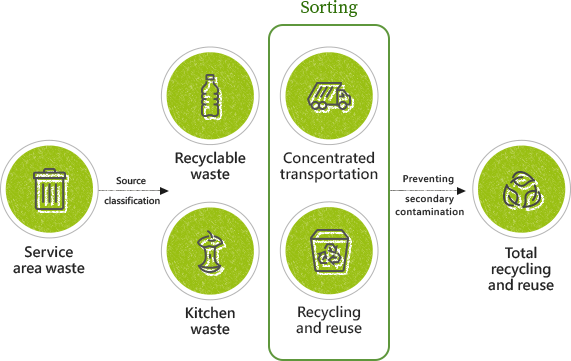
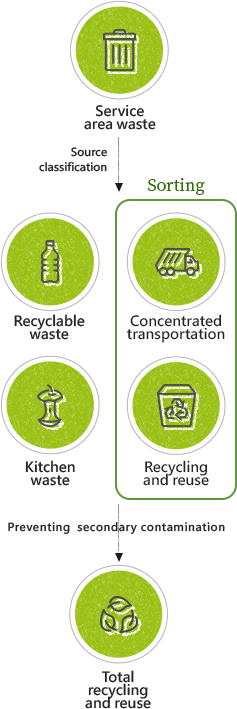

Effective & Rigorous Control Processes
Are Our Persistence & Faith in Safeguarding the Planet




